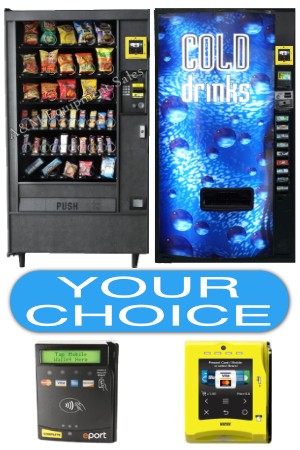Vending Business Accounts Effective Selling How do you effectively sell vending machine accounts? That’s the million dollar question, the solution to all of your problems, right? I hate to break it to you, but more accounts will not necessarily solve your problems. In fact, having more accounts could exacerbate your problems and even quicken your business’ demise.
So let’s define effective selling: Vending Business Accounts Effective Selling Effective selling is obtaining profitable business, developing a working relationship with the accounts so the situation benefits both you and your customers.
Anyone can obtain new accounts by offering lower prices, bigger commissions, new machines, or sandwich/frozen/cold food machines. You might find that your competitors offer all of these. But this is not effective selling. Your challenge is to focus on profit and profitability, and let your competitors create their own problems.
One of the biggest challenges in selling vending accounts is deciding what makes a good/profitable account. Let’s look at a couple of scenarios.
You obtain two leads: one is a small business (25 employees, one shift) in an industrial park you are already servicing, the other is a very large facility (350 employees, 24/7 operations) that is across town.
You learn that both companies currently have vendors in their locations now, but are considering change. You set appointments to meet with both.
What now? Your goal is to make an objective assessment of the locations, determine their expectations, and decide if you can meet their needs profitably. Information is key, and this is the best (and easiest) time to gather any information that could be valuable in your endeavors. I strive to ask questions like:
- Who is servicing the account now? What do I know about this company? Are they reputable, good people? Do they generally provide good service? Do they effectively service the area and account in question? Are they using bottler’s assets?
- Why is the account considering changing vendors? Ask the question and let them talk, find out all you can about how they are being serviced now, what they like and dislike about their current service, what they would change.
- What is their expectation for equipment and for service scheduling? What are the hours of operation and/or access to the location?
- What is the pricing and do they expect commissions? Is the account open to a different pricing/commission structure?
- What is the distance from the truck parking to the machines, first floor, second floor, elevator, stairs, and dock? How quickly can it be serviced?
- Number of expected patrons? How many people have access to using your machines? How much indirect competition do you have (fast food restaurants or convenience stores within walking distance)?
- What are the demographics of the account? Age, gender, cultural and ethnic factors all relate to sales of product. What are the environmental conditions in the account?
- How easily is equipment moved into the location? Look for narrow hallways, large steps, short doors, tile and hardwood floors – any factors that could affect the move or that might induce unexpected liability.
In our scenario, you find that the 25-person account is being run by an operator you don’t know. He has told the customer that he is a part-timer who operates “blue sky” machines out of his garage. The customer relates to you that the machines are unreliable and that, while he makes a good effort to repair them, they just don’t seem to be fixed. The customer likes the selection offered, and the machines are full most of the time (mainly because the operator is out every other day to fix the machines and he restocks while he’s there). The customer has had several conversations about the reliability issue, but has had no solution to the problem.
You notice that the machines are in a small break room, down a narrow hallway, and they dominate the break room. You also notice that the demographics of the account are largely young males working in a warehouse with no climate control. There are 20 warehouse workers and five office staff. The warehouse ships and receives freight, and you notice a couple of truck drivers waiting in the warehouse. The operating hours are from 7:30 am to 9 pm (warehouse 7:30 am to 3:30 pm and office staff till 9 pm). The dock has a drive-up garage door, as well as 8 dock facilities. The building is in the middle of an industrial park; the nearest restaurant is a little over a mile away. The customer indicates they don’t want commission, just good service with machines that work.
Your visit to the 350-person account finds an account that is run by a local independent vendor you know. They run a tight operation, provide good service, and are generally very difficult to remove from accounts. The operation runs 24/7 and you notice that the current vendor has equipment that is 2-3 years old, and are using bottler’s assets. The location is in a secured facility, with a security checkpoint at the entrance and a pass card at the door. The break room is on the second floor, accessible by elevator. The facility is a service center for a large insurance company and is staffed largely by older women. There are several restaurants within walking distance and you notice delivery brochures in the break room. The break room has ceramic tiled floors.
The customer indicates that they are looking for a new vendor because the machine never has the healthy snack items that they want, and they are not servicing the machines quickly enough when there’s a problem. You ask about the service issue, and the customer responds that the drink machine took someone’s money last fall, and the vendor, arriving 2 hours later, could not find the problem with the machine.
The vendor pays a 25% commission – pricing is in your low range – and you learn that they are tardy in paying their commission payments, which they get on the 15th of the month. The customer really thinks their pricing is too high; they go to Sam’s Club and see that their current vendor is making too much money. You discover that their current vendor is the third vendor they have had in five years.
For those of you not experienced in the vending business, these are actual cases; if you’ve worked in vending for awhile, you’ve probably just pictured several of your customers.
Which account is more profitable? You be the judge. Both have their positive and negative factors.
For the first account, I would suggest putting full-size vending machines in the warehouse area close to the dock door. Free up the space in their break room (you wouldn’t want to move or service equipment in there, anyway). I would put in refurbished older machines, properly set up and maintained with perfection. I would set their service schedule at two weeks with the understanding that they can call anytime for service within 24 hours. Pricing would be on the high side, with an explanation that “professional service” is more costly and that the need to raise prices will be far into the future.
The second account, I would be blunt. I would offer new equipment with premium pricing, offering coffee service as commission. I would stress a high degree of professionalism, and if they want the best, they will have to pay for it. I might offer a second option of leasing them equipment and letting them have an employee take care of the machines; they could keep the profit. This type of account is what I refer to as a revolving door account; they have a new vendor every year, have no loyalty, and do not value service.
My goal with this article is to get you to ask the pertinent questions, to analyze an account for all it’s worth. Don’t be fooled by numbers alone. While large numbers are generally better, there are many factors that determine profitability. Understanding the various factors involved with operating a vending route can be the difference between success and failure.
If you have not read the previous parts of this series, I suggest you do so.
Together, these articles present a comprehensive overview of the vending business, so each article shows only a small cross-section of the business. Success in any one area does not mean your business will be successful; it’s important to understand the dynamics – the relationship between the various activities – to be effective.Vending Business Accounts Effective Selling
More interesting blogs Vending Sales Secrets



